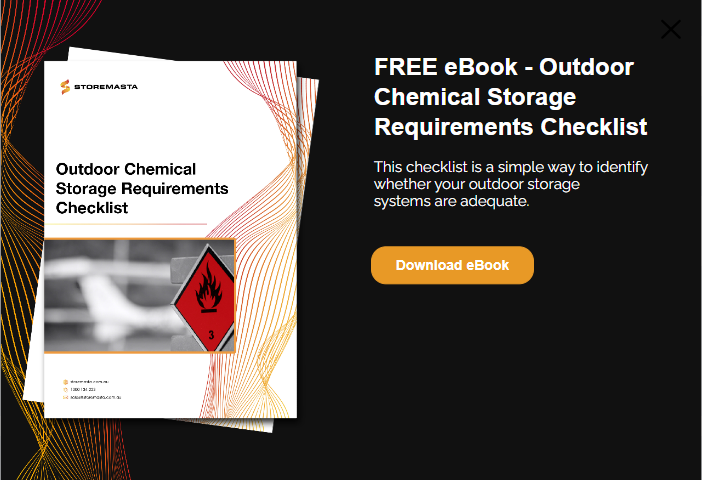Are you one of the many organisations that rely on engine oil to run your daily operations? Whether you need engine oil for your heavy equipment or a fleet of delivery vehicles, it’s important to ensure safe, quick and convenient access to your oil drums. However, due to the flammability and spill risk associated with the storage of engine oil, there are some essential considerations you must make when you’re deciding how and where to store your oil drums. In this blog, we’ll be taking a closer look at engine oil and the risks associated with its use. We’ll also detail how you can store oil drums outdoors while reducing risk for your business.
What Is Engine Oil?
Engine oil is manufactured from the fractional distillation of crude oil. Oil is an ideal lubricant for engines as it’s a viscous petrochemical that can withstand high temperatures.
When oil is pumped through the engine of a vehicle or machine, it provides the necessary lubrication to allow the engine components to move smoothly. Therefore, engine oil offers protection for the components by safeguarding them against damage caused by friction and corrosion.
 While they’re a common site in workplaces across the country, drums of engine oil must be stored safely to reduce risk to people, property and the environment.
While they’re a common site in workplaces across the country, drums of engine oil must be stored safely to reduce risk to people, property and the environment.
Is Oil Classed As A Dangerous Good?
While oil is a substance that is necessary for both engine performance and longevity, the substance does pose a range of risks for businesses that carry it. Engine oils are classed as combustible liquids and are therefore recognised as Dangerous Goods.
Oil, while not technically classed as a flammable liquid, can still ignite in the presence of an ignition source. However, the temperature at which ignition can occur is a relatively high temperature that is outside the normal working temperature range.
The Flash Point Of Engine Oil
At temperatures greater than 150 °C, oil will emit enough hazardous vapours to create and sustain a fire. This temperature is known as the flash point of a substance — and is key in determining whether a hazardous chemical is flammable or combustible. Unlike flammable liquids such as petrol, methanol or kerosene (which can ignite at room temperature) engine oil must reach a higher temperature before it is susceptible to ignition.
The Australian Standard which details the requirements for engine oil is AS 1940:2017 – The storage and handling of flammable and combustible liquids. The Standard explains that combustible liquids are divided into two categories: Class C1 combustible liquids (which have a flash point of more than 60°C but no more than 93°C.) and Class C2 combustible liquids (which have a flash point more than 93°C). Therefore, due to the high flash point of engine oil, they are classified as C2 combustible liquids.
What Risks Are Associated With Oil Drum Storage?
When you’re working with a combustible liquid, such as engine oil, you must ensure that the substance is handled and stored in such a way as to effectively reduce risk.
There are several risks associated with the handling and storage of engine oil. These include:
- Fire and explosion – under high temperatures in the presence of an ignition source
- Asphyxiation and human harm – if hazardous vapours are inhaled or oil is spilt on workers
- Environmental damage – if the substance reaches the natural environment, or penetrates soil or waterways
To reduce the dangers associated with engine oil storage, you should always ensure that your storage equipment is designed and constructed to meet the requirements of the Australian Standards.
While there are many compliant ways to store oil drums, perhaps the simplest (and one of the most popular) solutions is choosing a compliant chemical container. These containers are designed for outdoor use and can store small to large quantities of engine oil.
We’ll now go into more detail about the safe storage of oil drums in this type of chemical storage container.
Features Of A Compliant Oil Drum Storage Container
In Section 4 of AS 1940:2017, you’ll find the details for the storage of oil (and other Class 3 liquids) in package stores. Each of these requirements are designed to reduce the risks associated with flammable and combustible liquids.

When selecting storage equipment for your oil drums, make sure that it meets the requirements of the Australian Standards.
Our range of chemical storage containers offer a range of features including:
- Adequate spill containment
- Natural ventilation system
- Dangerous Goods and safety signage
- Corrosive-resistant sheet steel construction
- Cambered roof for rain runoff
- ISO locking bars for secure outdoor storage
- Easy access doors with 270° hinging
- Forklift channels for relocations
- Earthing steak and mounting
Not only do chemical storage containers provide the necessary risk controls, they also offer a protected, dedicated space for you to store your Dangerous Goods.
This encourages staff to follow the correct storage, loading and stacking procedures — instead of leaving oil drums lying around in unsafe conditions. When you’re working with any type of Class 3 liquid, you don’t want to find your drums left unattended on the floor — or haphazardly stacked on wooden pallets.
How Chemical Storage Containers Reduce Risk
It's now time to take a deeper dive into how compliant oil drum storage can reduce risk.
Containing Chemical Spills
If your storage facilities are to meet the requirements of AS 1940:2017, you must ensure that there is adequate spill containment for your engine oil drums. Chemicals leaks and spills from oil drums can cause a range of issues for the people, property and environment of your organisation.
Therefore, you must ensure that there is a spill containment system to reduce the likelihood and impact of such as spill.
If you’re storing less than 10,000 litres of engine oil, the spill containment capacity must be 100% of the largest package within the store, plus 25% of the aggregate capacity.
For stores between 10,000 and 100,000 litres, the spill containment capacity must be 100% or the largest package, plus 25% of the aggregate capacity of the store, and 10% of storage capacity between 10,000 and 100,000 litres.
If you’re storing quantities of engine oil that are greater than 100,000 litres, then the spill capacity must equal 100% of the largest package, plus 25% of the aggregate capacity, and 10% of storage capacity (between 10,000 and 100,000 litres) and 5% of the storage capacity exceeding 100,000 litres.
Any spills of leaks from your oil drums must be directed into your spill compound — which must never be used as a storage facility or for any other purpose. To ensure that the capacity of the spill compound isn’t compromised, you must ensure that regular inspections and housekeeping is applied to your oil drum stores and that any leaks or spills are cleaned up and disposed of in a safe manner.
Reducing The Build-Up Of Hazardous Vapours
Hazardous vapours from combustible liquids can cause serious health issues for staff who work with these substances. They can also increase the risk of fire and explosion in the workplace.
Compliant storage facilities for engine oil drums should provide a natural ventilation system that allows hazardous vapours to escape the container. This can be achieved if outdoor stores are equipped with (at least) two walls of louvres and perforated shelving. These features allow air to move freely through the chemical storage container, without the build-up of dangerous vapours within the storage equipment.
As chemical containers are designed for use in the outdoor environment, they enable the natural dispersion of hazardous vapours. However, if oil drum stores are located inside a building, then a mechanical ventilation system may have to be considered. Specifically, you will have to consider the installation of a mechanical ventilation system if the vapour levels exceed those exposure standards published by Safe Work Australia.
Minimising The Risk Of Fire and Explosion
As stipulated in the Standard, any flammable or combustible liquid must be stored away from any type of ignition source by a distance of at least 3 metres.
This includes everyday items found in the workplace such as:
- Pilot lights
- Power points
- Electric lamps
- Soldering irons
- Naked flames
- Cigarette lighters
When determining the location for your stores of oil drums, you must make sure that there is no ignition source located within the area. You should also train all staff who are handling and storing these liquids to correctly identify ignition sources — and ensure their removal from the area. Remember, any prohibited item (such as a lighter) that is accidentally brought into a storage area can trigger the ignition of your engine oil.
While the flash point of oil is higher than other flammable liquids, there is a real risk of a workplace fire escalating if it meets your stores of oil. To reduce this risk, Class 3 containers are constructed with dual-walled sheet steel and a thermic air barrier. These features aim to slow down the spread of flames and act as a barrier against excessive heat. While your chemical container won’t provide complete protection for your oil drums, it will create a protective layer that allows your staff to activate emergency procedures and firefighting equipment.
It's also important to install your chemical storage container in the correct way if you wish to maintain WHS compliance. When selecting a location for your oil drum storage container, make sure you choose a spot that is away from protected places, boundaries and ignition sources. You should also implement good housekeeping procedures to ensure that the area is kept clean, organised and free from combustible items. Paper files, uniforms, paint brushes or brooms will only act as fuel for a workplace fire. All care must be taken to prevent such an incident from occurring in your Dangerous Goods stores.
 You should always properly install and maintain your chemical storage container to ensure the highest levels of workplace safety.
You should always properly install and maintain your chemical storage container to ensure the highest levels of workplace safety.
How Is Your Engine Oil Being Stored?
If you’re storing engine oil drums at your workplace, please refer to the handling and storage guidelines of AS 1940:2017. Storage containers that are designed and built to meet these requirements offer superior protection against the many risks associated with the use of engine oil in the workplace. To find out more about storing oil drums (or other Dangerous Goods), why not access our handy checklist? Outdoor Chemical Storage Requirements will help you determine your storage needs, in an accessible and easy-to-understand format. Get your free copy today.
Joining the team as a Dangerous Goods Storage Consultant, Melissa Hampton became Storemasta's Marketing Manager in late 2021. With extensive knowledge and experience in chemical compliance, Melissa is responsible for leading the Marketing team and helping shape their marketing strategy. In her spare time, you can find Melissa hiking, swimming and enjoying the great outdoors in beautiful north-west Tasmania.

